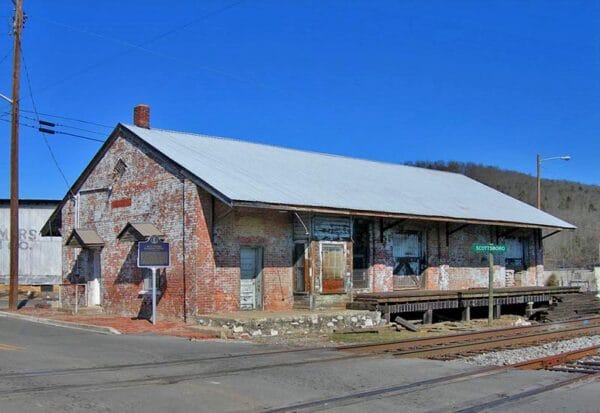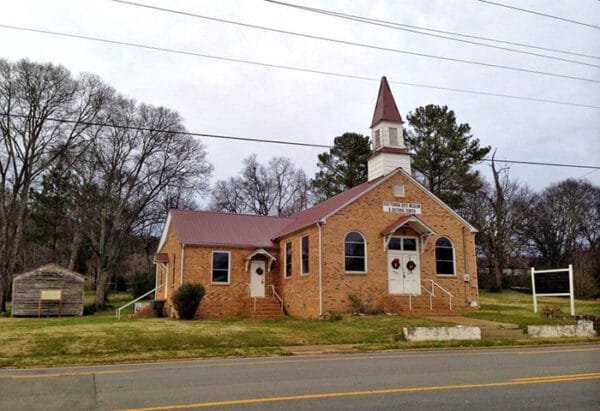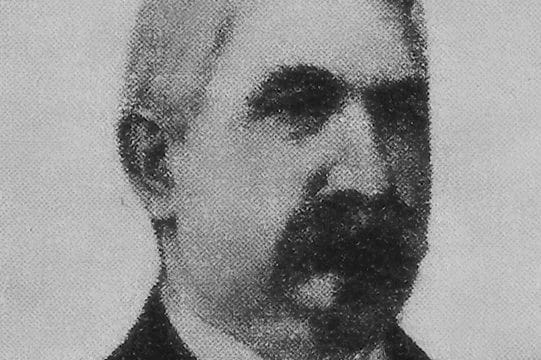Scottsboro
 Brown-Proctor House
Located in the mountainous northeastern corner of Alabama on the banks of Lake Guntersville on the Tennessee River, Scottsboro serves as the county seat of Jackson County. The town is named after its founder, Robert T. Scott, who migrated from North Carolina and in 1856 established a rail station on his land in Jackson County. Originally named Scottsville, the town’s name was changed to Scott’s Mill and then in 1858 to Scottsboro. In the 150 years since its founding, Scottsboro has developed from a small stop on the Memphis and Charleston rail line to a city rich in both history and natural beauty. Scottsboro has a mayor-council form of government. The city has a mayor/council government.
Brown-Proctor House
Located in the mountainous northeastern corner of Alabama on the banks of Lake Guntersville on the Tennessee River, Scottsboro serves as the county seat of Jackson County. The town is named after its founder, Robert T. Scott, who migrated from North Carolina and in 1856 established a rail station on his land in Jackson County. Originally named Scottsville, the town’s name was changed to Scott’s Mill and then in 1858 to Scottsboro. In the 150 years since its founding, Scottsboro has developed from a small stop on the Memphis and Charleston rail line to a city rich in both history and natural beauty. Scottsboro has a mayor-council form of government. The city has a mayor/council government.
History
 Scottsboro Train Depot
The establishment and development of Scottsboro resulted largely from the efforts of local resident Robert Scott, who in the late 1840s had moved to the area from nearby Bellefonte, then the county seat. Scott established a grist mill and a shingle factory and convinced the Memphis and Charleston railroad to run the rail line through his property. The rail traffic soon expanded the local adjacent village, known as Scott’s Mill. Just as the importance of rail traffic eclipsed that of river commerce, so Scottsboro soon eclipsed Bellefonte as the political and business center of Jackson County. On Friday, November 13, 1868, by order of the court commissioners, county records and activities were moved from Bellefonte to Scottsboro, establishing it as the county seat. Between 1868 and 1930, Scottsboro steadily grew from town to city. Sawmills and cotton gins were established in the 1880s, and by the turn of the century Scottsboro was home to hotels, schools, several law and medical offices, an opera house, and a newspaper. On October 5, 1927, Col. Charles Lindbergh visited Scottsboro and performed stunts in his aircraft, The Spirit of St. Louis, before flying on to Chattanooga.
Scottsboro Train Depot
The establishment and development of Scottsboro resulted largely from the efforts of local resident Robert Scott, who in the late 1840s had moved to the area from nearby Bellefonte, then the county seat. Scott established a grist mill and a shingle factory and convinced the Memphis and Charleston railroad to run the rail line through his property. The rail traffic soon expanded the local adjacent village, known as Scott’s Mill. Just as the importance of rail traffic eclipsed that of river commerce, so Scottsboro soon eclipsed Bellefonte as the political and business center of Jackson County. On Friday, November 13, 1868, by order of the court commissioners, county records and activities were moved from Bellefonte to Scottsboro, establishing it as the county seat. Between 1868 and 1930, Scottsboro steadily grew from town to city. Sawmills and cotton gins were established in the 1880s, and by the turn of the century Scottsboro was home to hotels, schools, several law and medical offices, an opera house, and a newspaper. On October 5, 1927, Col. Charles Lindbergh visited Scottsboro and performed stunts in his aircraft, The Spirit of St. Louis, before flying on to Chattanooga.
Scottsboro remained out of the international spotlight until March 1931, when nine young African American men were falsely accused of rape by two white women. Their subsequent trials were held in Scottsboro and marked the beginning of a long legal battle in which the gross inequities of the Alabama justice system became an international spectacle. The trials generated great interest, inspired a number of literary and artistic works, including Harper Lee‘s To Kill a Mockingbird, and for generations made the name Scottsboro synonymous with racial injustice.
 Scottsboro Industry
From its founding and through the first half of the twentieth century, Scottsboro’s economy was based largely on agriculture and lumber production, but the creation of the federal Tennessee Valley Authority (TVA) in 1933 set Scottsboro and the surrounding region on a different economic path. By making the Tennessee River fully navigable and harnessing it for abundant hydroelectric power, TVA modernized north Alabama and set the stage for economic development. With ample rail service, a navigable waterway, and abundant electric power, Scottsboro’s industrialization began in the 1950s with the establishment of additional textile plants and diversified in the 1960s to include facilities for Revere Aluminum and Goodyear Tire & Rubber. In 1974, TVA was granted a license to construct the Bellfonte nuclear power plant at the site where the town once stood. The plant was partially constructed and then abandoned in 1988 after a $4 billion investment; in 2006, the TVA sold off most of the equipment.
Scottsboro Industry
From its founding and through the first half of the twentieth century, Scottsboro’s economy was based largely on agriculture and lumber production, but the creation of the federal Tennessee Valley Authority (TVA) in 1933 set Scottsboro and the surrounding region on a different economic path. By making the Tennessee River fully navigable and harnessing it for abundant hydroelectric power, TVA modernized north Alabama and set the stage for economic development. With ample rail service, a navigable waterway, and abundant electric power, Scottsboro’s industrialization began in the 1950s with the establishment of additional textile plants and diversified in the 1960s to include facilities for Revere Aluminum and Goodyear Tire & Rubber. In 1974, TVA was granted a license to construct the Bellfonte nuclear power plant at the site where the town once stood. The plant was partially constructed and then abandoned in 1988 after a $4 billion investment; in 2006, the TVA sold off most of the equipment.
Demographics
According to 2020 Census estimates, Scottsboro recorded a population of 14,452. Of that number, 89.2 percent of respondents identified themselves as white, 5.3 percent as African American, 3.9 percent as Hispanic, 1.6 percent as two or more races, 0.9 as Asian, 0.6 percent as Native American, and 0.2 Native Hawaiian and Other Pacific Islander. The town’s median household income was $43,713, and the per capita income was $27,079.
Employment
According to 2020 Census estimates, the workforce in Scottsboro was divided among the following industrial categories:
- Educational services, and health care and social assistance (25.8 percent)
- Manufacturing (22.4 percent)
- Retail trade (11.7 percent)
- Professional, scientific, management, and administrative and waste management services (10.4 percent)
- Arts, entertainment, recreation, accommodation, and food services (8.3 percent)
- Public administration (4.6 percent)
- Other services, except public administration (4.3 percent)
- Transportation and warehousing and utilities (3.3 percent)
- Construction (3.0 percent)
- Finance, insurance, and real estate, rental, and leasing (2.2 percent)
- Information (1.8 percent)
- Wholesale trade (1.5 percent)
- Agriculture, forestry, fishing and hunting, and extractive (0.5 percent)
Education
The Scottsboro City School System consists of three elementary schools, two middle schools, and one high school.
Transportation
Scottsboro is located at the crossroads of major roadways, rail lines, and waterways. The Tennessee River, which runs through Scottsboro and surrounding municipalities, is part of a large river system that connects 21 states to the Gulf of Mexico. Barge shipments on the waterway reach the deep-water port of Mobile in approximately four and one half days. Located on Highway 72 between Huntsville (Madison County) and Chattanooga, Tennessee, Scottsboro is within a one-hour drive to five major interstates: I-565, I-65, I-24, I-59, and I-75. Three railroads, CSX, Norfolk Southern, and Sequatchie Valley, serve the freight needs of Scottsboro. The municipal airport, with a 5,250-foot lighted runway, is primarily used for private air traffic.
Events and Places of Interest
 Payne’s Soda Shop in Scottsboro
Scottsboro and the surrounding area offer many opportunities for outdoor recreation. The 69,000-acre Lake Guntersville, known for its fishing and boating, is accessible from several city and county parks. Jackson County Park, located on the lake, offers numerous recreational opportunities and hosts the annual Catfish Festival each May. Goose Pond Colony, a municipally owned resort on the lake, offers two 18-hole championship golf courses, lakeside cottages, a lodge, campground, marina, pool, and restaurant. King Caldwell Park, named for Scottsboro native and oil magnate David King Caldwell, is also located downtown and offers visitors nature trails, picnic facilities, and a playground. Annually, the park is the site of Art Sunday, an arts and crafts festival held on the first Sunday before Labor Day. In addition to above-ground recreation, Jackson County is home to more than 1,500 charted caves, more than half of all the caves in the state of Alabama.
Payne’s Soda Shop in Scottsboro
Scottsboro and the surrounding area offer many opportunities for outdoor recreation. The 69,000-acre Lake Guntersville, known for its fishing and boating, is accessible from several city and county parks. Jackson County Park, located on the lake, offers numerous recreational opportunities and hosts the annual Catfish Festival each May. Goose Pond Colony, a municipally owned resort on the lake, offers two 18-hole championship golf courses, lakeside cottages, a lodge, campground, marina, pool, and restaurant. King Caldwell Park, named for Scottsboro native and oil magnate David King Caldwell, is also located downtown and offers visitors nature trails, picnic facilities, and a playground. Annually, the park is the site of Art Sunday, an arts and crafts festival held on the first Sunday before Labor Day. In addition to above-ground recreation, Jackson County is home to more than 1,500 charted caves, more than half of all the caves in the state of Alabama.
 Scottsboro Boys Museum and Cultural Center
The Scottsboro Boys Museum and Cultural Center offers visitors exhibits about the history of civil rights in Alabama, beginning with the infamous Scottsboro Trials. The Scottsboro Jackson Heritage Center is a multi-structure historical site that interprets the history and traditions of the county’s citizens. Scottsboro also hosts several unique shopping opportunities. First Monday Trade Day, more than a century old and typically beginning on the Sunday preceding each first Monday of the month, is a traditional outdoor flea market that takes place on the Courthouse Square. The most famous shopping attraction in Scottsboro, however, is the Unclaimed Baggage Center, a huge outlet where lost baggage from airline and bus companies is sold. The eclectic variety of lost items made available for sale at the store attracts nearly a million visitors a year, making it one of Alabama’s top attractions.
Scottsboro Boys Museum and Cultural Center
The Scottsboro Boys Museum and Cultural Center offers visitors exhibits about the history of civil rights in Alabama, beginning with the infamous Scottsboro Trials. The Scottsboro Jackson Heritage Center is a multi-structure historical site that interprets the history and traditions of the county’s citizens. Scottsboro also hosts several unique shopping opportunities. First Monday Trade Day, more than a century old and typically beginning on the Sunday preceding each first Monday of the month, is a traditional outdoor flea market that takes place on the Courthouse Square. The most famous shopping attraction in Scottsboro, however, is the Unclaimed Baggage Center, a huge outlet where lost baggage from airline and bus companies is sold. The eclectic variety of lost items made available for sale at the store attracts nearly a million visitors a year, making it one of Alabama’s top attractions.
The Memphis and Charleston Railroad Depot, built in 1856, stands near the square in the downtown area, as does Payne’s Soda Shop, which opened in 1869.
Further Reading
- Carter, Dan. Scottsboro: A Tragedy of the American South. Baton Rouge: Louisiana State University Press, 1969.
- Gist, W. Jerry. The Story of Scottsboro, Alabama. Nashville, Tenn.: Rich Printing Company, 1968.
- Hammer, Walt. A Pictorial Walk Thru Ol’ High Jackson. Collegedale, Tenn: College Press, 1967.
- Heritage of Jackson County, Alabama. Clanton, Ala.: Heritage Publishing Consultants, 1998.
- Kennamer, John Robert. The History of Jackson County. Winchester, Tenn.: Southern Printing and Publishing Company, 1935.



